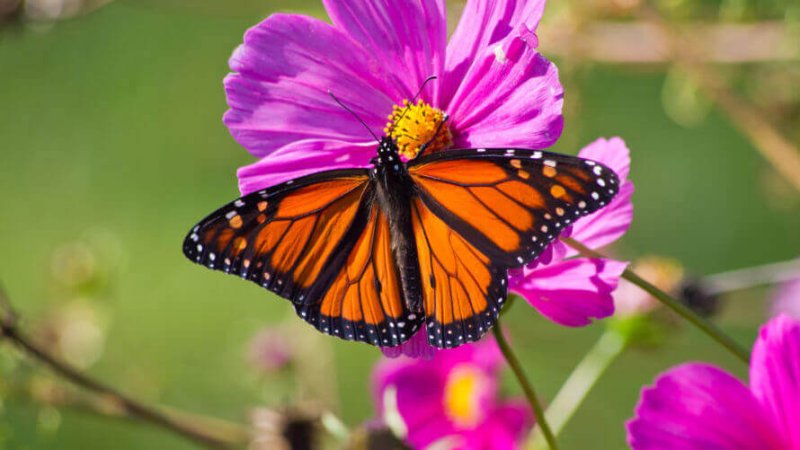The long-term decline of monarch butterflies has been attributed to loss of their milkweed (Asclepias sp.) host-plants after the introduction of herbicide-tolerant crops. However, recent studies report pesticide residues on milkweed leaves that could act as a contributing factor when ingested as part of their larval diet.
In this study, we exposed monarch larvae to six pesticides (insecticide: clothianidin; herbicides: atrazine, S-metolachlor; fungicides: azoxystrobin, pyraclostrobin, trifloxystrobin) on their primary host-plant, A. syriaca. Each was tested at mean and maximum levels reported from published analyses of milkweeds bordering cropland and thus represent field-relevant concentrations.
[Editor’s note: To learn more, read our FAQ Is the Monarch butterfly threatened with extinction by herbicide resistant GMOs?]
Monarch lethal and sub-lethal responses were tracked over their complete development, from early instar larvae to adult death. Overall, we found no impact of any pesticide on immature development time and relatively weak effects on larval herbivory or survival to adulthood. Comparatively stronger effects were detected for adult performance; namely, a 12.5% reduction in wing length in response to the fungicides azoxystrobin and trifloxystrobin.
These data collectively suggest that monarch responses to host-plant pesticides are largely sublethal and more pronounced in the adult stage, despite exposure only as larvae.
…
[B]ased on the results from this experiment combined with several other recently published studies, it seems unlikely that neonicotinoids are one of the primary drivers of monarch declines. This is not to say that neonicotinoids are completely innocuous, but compared with other ongoing threats (e.g., loss of milkweed host-plants and overwintering habitat), they likely play a secondary role.A continental-scale analysis that statistically teased apart the relative importance of multiple anthropogenic factors implicated in the decline ultimately came to the same conclusion. However, more data are clearly needed on responses by adult butterflies to variation in exposure via nectar, understudied variables like fecundity, and sublethal effects on ecologically-relevant behaviors (e.g., mating, oviposition, migration).
…
While neonicotinoids have received the lion’s share of attention, field surveys of pesticides residues on milkweed reveal a diversity of active ingredients that warrant additional toxicity testing for monarchs. Our data specifically point to fungicides as a group that should be investigated more in the future.
Last, it is essential to consider the delayed, sublethal effects that are expressed on adult performance traits. Unfortunately, these are the most time consuming and challenging to measure but most directly linked with monarch fitness and migratory success. Pesticide risk assessment needs to consider these effects on adult parameters, particularly for migratory species, whenever possible.































